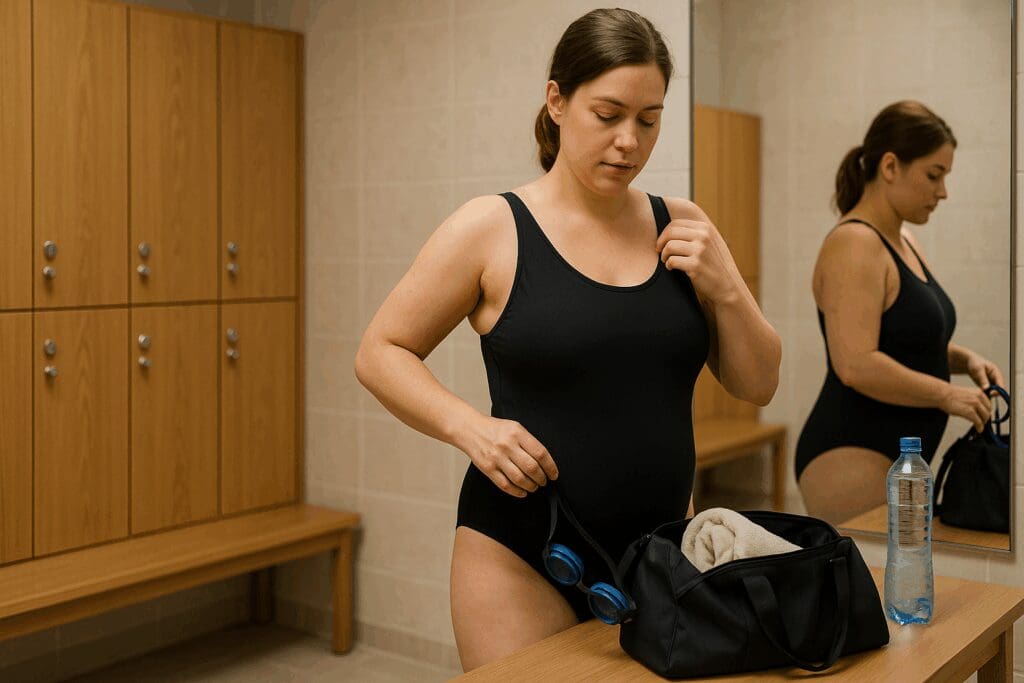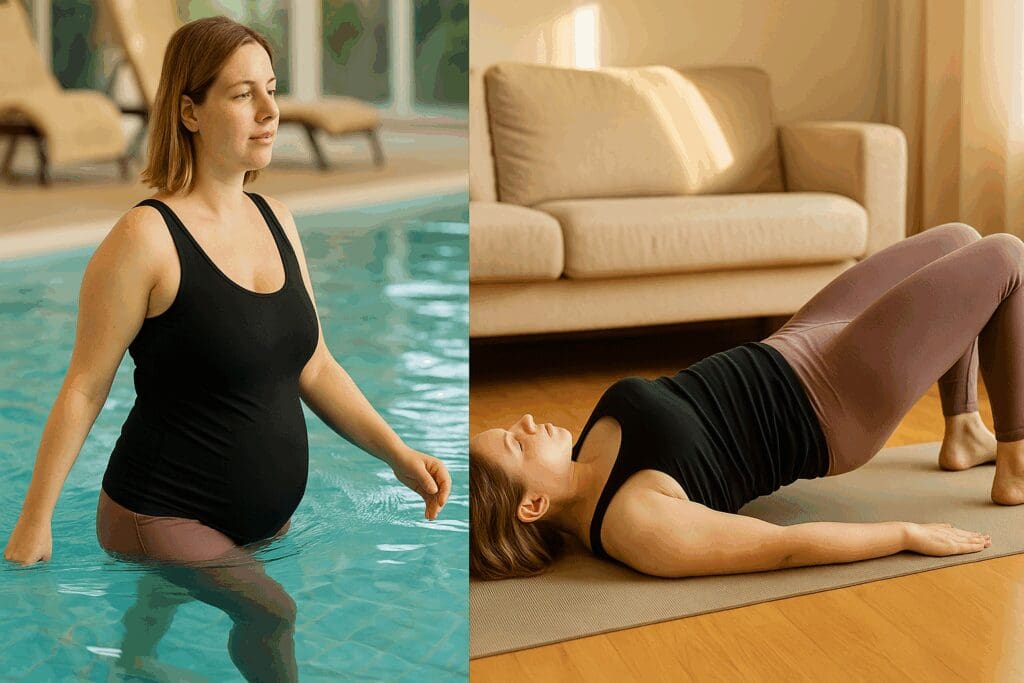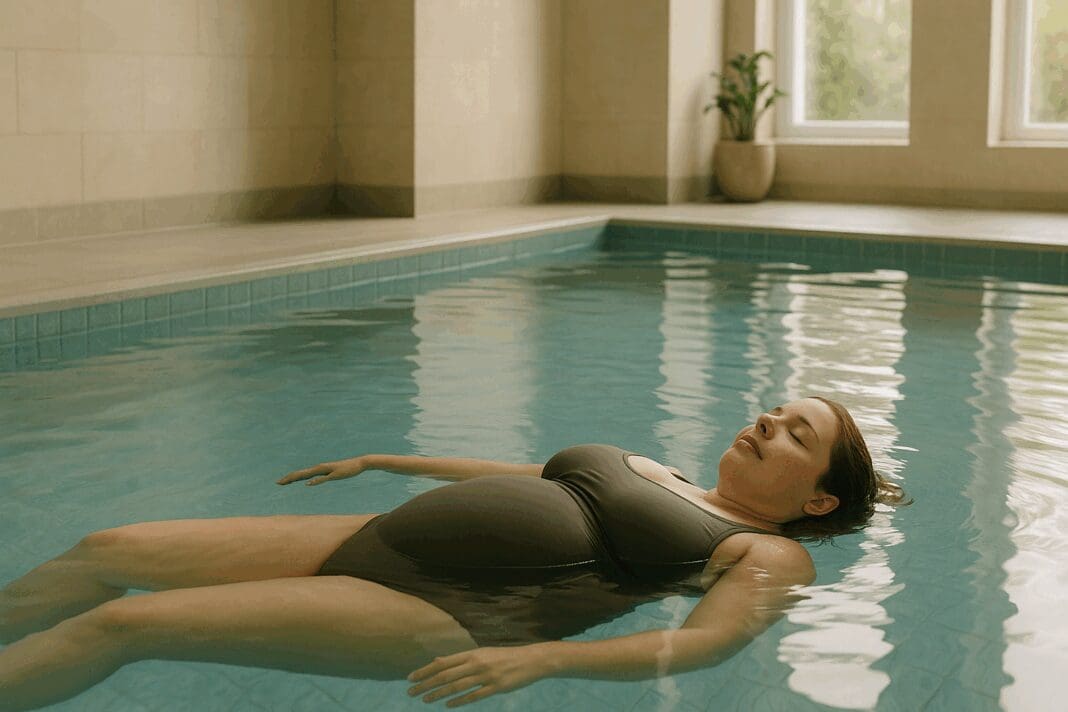The journey into motherhood brings with it profound physical and emotional changes, especially after a cesarean delivery. Among the many questions new mothers have during postpartum recovery is whether and when they can return to physical activities like swimming. Swimming after c section is a topic of increasing interest, not only because it offers a refreshing way to exercise but also because it supports muscle rehabilitation and mental wellness. For many new moms, swimming represents a joyful, low-impact way to reconnect with their bodies, regain strength, and feel more at ease. Yet, this activity must be approached with caution and preparation to ensure safety and efficacy.
You may also like: Essential Tips for Navigating Emotional and Physical Changes at 8 Months Postpartum
Understanding Your Body’s Healing Process After a Cesarean
Before diving into the practical aspects of swimming, it’s essential to understand the recovery process your body undergoes following a cesarean section. A c-section is a major abdominal surgery that involves incisions through the abdominal wall and uterus, which means healing times are not uniform and vary by individual. Typically, the initial phase of recovery lasts about six weeks, though some women may need longer depending on complications or overall health. Scar tissue formation, internal healing, and hormonal shifts all contribute to how soon one might return to physical activity.
Physicians emphasize that returning to exercise too early can disrupt healing and potentially lead to complications like wound reopening, infections, or prolonged discomfort. Recognizing signs that your body is ready, such as reduced pain, the absence of bleeding, and your doctor’s clearance, is fundamental. When asking questions like “when can i exercise after c section” or “after a cesarean when can i exercise,” it’s important to base the answer not just on a calendar date but also on individualized health markers. Engaging in self-awareness and regular medical check-ups creates a safer path back to activities like swimming.

Why Swimming Is an Ideal Postpartum Exercise
Swimming stands out as one of the most beneficial forms of exercise for postpartum women, especially those recovering from a cesarean. Water provides natural resistance that helps tone muscles without putting stress on joints or healing tissues. The buoyancy also offers relief from the gravitational strain on the abdomen and lower back, areas commonly affected during pregnancy and childbirth. This makes swimming a therapeutic and rejuvenating activity that supports gentle cardiovascular engagement.
Additionally, the act of being immersed in water can bring emotional and psychological relief. For new mothers dealing with hormonal fluctuations and potential postpartum depression, swimming can offer a serene, meditative environment that contributes to mental wellness. Questions such as “when should i start exercising after c section” or “how long after c section can you workout” are not merely about physical readiness but also about emotional rejuvenation. Swimming accommodates both.
When Can You Safely Resume Swimming After C Section?
The timing of when to resume swimming after c section is one of the most common inquiries among new mothers. In general, healthcare providers recommend waiting until the incision has fully healed and any vaginal bleeding (lochia) has ceased. This typically occurs between six to eight weeks postpartum. However, every woman’s recovery trajectory is unique, and therefore, clearance from a healthcare provider is non-negotiable before stepping into a pool.
Swimming too early poses several risks, including infections if bacteria enter the body through an incompletely healed incision or cervix. Furthermore, while water may seem clean, public swimming pools can harbor microorganisms that are harmless to others but potentially dangerous to postpartum women. Thus, those asking “how long after c section can you swim” must be aware that safety hinges on a combination of wound healing, cessation of lochia, and professional approval. Incorporating swimming too soon into post cesarean workout routines can inadvertently delay overall recovery.
Warning Signs to Delay Swimming or Exercise
Even if you’ve reached the six-week mark, certain symptoms indicate your body may not yet be ready for swimming. Persistent incision pain, redness or swelling at the surgical site, ongoing bleeding, or a feeling of heaviness in the pelvic area are all red flags. Similarly, emotional signs like fatigue, mood swings, or anxiety may suggest the need for further rest and support before engaging in physical activities.
It’s crucial to distinguish between normal recovery sensations and symptoms that require medical attention. For example, mild discomfort during movement may be expected, but sharp or radiating pain is not. Questions such as “when can you start exercising after c section” are best answered in consultation with a healthcare provider who can evaluate both physical and emotional readiness.

Swimming After C Section: Practical Preparation Tips for New Moms
Preparation is key to a safe return to swimming after c section. Begin with light stretching and breathing exercises approved by your physician to gently reintroduce mobility. Once cleared, choose a clean and well-maintained swimming facility with appropriate hygiene standards. Wearing a well-fitted, supportive swimsuit can provide comfort and help you feel more secure in your movements.
Hydration is equally essential, as breastfeeding mothers are at greater risk of dehydration. Drink ample water before and after swimming to maintain energy and avoid fatigue. Also, avoid high-intensity swimming or laps initially. Start with floating, light kicks, or water walking to allow your body to adapt. Integrating these mindful steps into your post cesarean workout plan encourages sustainable progress without overwhelming your healing body.

Designing Post Cesarean Workout Plans That Include Swimming
Creating a balanced and progressive exercise routine after a c-section involves more than jumping back into pre-pregnancy fitness levels. Swimming can serve as a cornerstone in a well-rounded postnatal workout plan, but it must be paired with other low-impact exercises that target strength, flexibility, and core stability. This holistic approach accelerates recovery and reduces the risk of injury.
Begin by incorporating short, 10- to 15-minute swimming sessions into your weekly schedule. As your stamina improves, gradually increase duration and complexity. Complement swimming with land-based exercises like pelvic tilts, kegel exercises, and yoga poses tailored to postpartum needs. These additions enhance core strength and pelvic floor function, which are vital areas impacted by pregnancy and cesarean delivery. Queries such as “when can you start working out after c section” or “when can i workout after c section” must be answered with individualized, adaptable plans that honor your body’s pace.
The Role of Medical Clearance in Postpartum Swimming and Exercise
Receiving medical clearance before resuming swimming or any exercise is more than a formality. It serves as an essential checkpoint to ensure your uterus has contracted adequately, bleeding has stopped, and there are no underlying issues such as infection or hernias. Some women may have had complications like preeclampsia, blood pressure irregularities, or extended hospital stays, which can alter the timeline for returning to physical activity.
Doctors also consider breastfeeding status, emotional health, and support systems before giving the green light. If you’re still uncertain about how long after c section can you workout or swim, this conversation with your healthcare provider can clarify your unique recovery needs. Personalized clearance ensures you avoid setbacks and build a recovery plan rooted in medical safety.

Emotional Wellness and Swimming: Healing Beyond the Physical
While much emphasis is placed on physical healing, the emotional dimension of postpartum recovery deserves equal attention. Many new mothers experience feelings of isolation, body image concerns, and mood fluctuations in the weeks following childbirth. Swimming offers a chance to reconnect with oneself in a calming and liberating environment. The rhythmic movements, the feel of water enveloping your body, and the simple act of moving freely can significantly improve mood and reduce anxiety.
Research shows that physical activity, including swimming, can alleviate symptoms of postpartum depression by stimulating endorphin production. By choosing an activity like swimming after c section, new moms can find a gentle yet effective tool for improving emotional resilience. Including mental health considerations in your overall recovery strategy not only speeds up physical healing but also enriches the motherhood experience.
Addressing Common Concerns About Swimming After C Section
New moms often have many concerns about returning to swimming, such as whether chlorine will affect their incision or if they should use tampons to manage post-birth bleeding. It’s important to note that chlorine is generally safe for healed wounds but can cause irritation if the skin is still sensitive or compromised. As for tampons, they should be avoided until your doctor confirms that internal healing is complete and your cervix has closed, typically around six weeks postpartum.
Concerns about milk supply and breastfeeding also arise. Swimming does not negatively impact lactation, although proper hydration and nutrition are essential. Wearing a supportive swimsuit and nursing before or after swimming can make the experience more comfortable. By dispelling these fears with accurate information, mothers can embrace swimming with confidence, knowing their concerns have been acknowledged and addressed.
Building a Long-Term Relationship with Fitness After a C Section
Returning to swimming after c section can mark the beginning of a positive, long-term relationship with fitness. As your body continues to heal and regain strength, swimming can evolve from a recovery tool into a regular part of your wellness routine. Unlike high-impact workouts, swimming remains gentle on joints and adaptable to different fitness levels, making it a sustainable choice for years to come.
In the months that follow childbirth, gradually increasing the intensity and diversity of your workouts can keep you motivated and energized. Consider joining a postpartum exercise class that includes aquatic sessions or working with a certified trainer who specializes in postnatal fitness. These resources can introduce variety while ensuring you maintain correct form and avoid injury. Regular exercise, including swimming, contributes to better sleep, increased energy levels, and improved cardiovascular health—all of which support the demands of motherhood.

How to Safely Progress From Swimming to More Intensive Workouts
As your confidence and stamina increase, you may begin wondering “how long after c section can you workout” with higher intensity or return to pre-pregnancy fitness routines. The key lies in gradual progression and attentive listening to your body. Start by increasing the duration of your swimming sessions, adding more laps, or experimenting with different strokes.
Once you feel stable and pain-free, you can introduce more structured workouts that include strength training, aerobic exercises, or even light jogging. Always prioritize core and pelvic floor health before advancing to more strenuous activities. Incorporating activities like Pilates or TRX can help rebuild internal muscle structures that support movement and posture. Throughout this transition, continue using swimming as a recovery day activity to maintain flexibility and cardiovascular endurance.
The Interplay Between Hormonal Recovery and Physical Activity
The hormonal landscape postpartum can significantly influence your energy levels, metabolism, and muscle recovery. Estrogen, progesterone, and oxytocin levels shift dramatically, impacting not only mood but also joint stability and tissue elasticity. Engaging in exercises like swimming after c section can help regulate these changes by stimulating circulation, promoting endorphin release, and supporting hormonal balance.
It’s important to understand that during the early weeks, your body may not respond to exercise the same way it did before pregnancy. Fatigue, emotional highs and lows, and the demands of infant care may affect your ability to commit to a rigid fitness schedule. Therefore, flexibility and compassion toward yourself are vital. Swimming offers the kind of adaptable routine that can accommodate these fluctuations, making it an ideal exercise during this sensitive time.
Frequently Asked Questions: Safe and Sustainable Postpartum Fitness Through Swimming and Exercise
Is Swimming After C Section Safe for Diastasis Recti Recovery?
Yes, swimming after c section can be safe and even therapeutic for women dealing with diastasis recti, a common separation of the abdominal muscles following pregnancy. The resistance of water allows for controlled, low-impact movements that help strengthen the core without putting undue stress on the healing muscles. However, it’s critical to focus on exercises that engage the transverse abdominis, the deep abdominal muscles, rather than the rectus abdominis, which can worsen the separation if strained. Gentle flutter kicks and floating back strokes can offer a safe way to activate the core while avoiding crunch-like movements. Consulting a pelvic floor therapist or a postnatal fitness specialist can provide personalized routines that support both healing and strength restoration.
How Does Swimming Compare to Other Workouts After C Section in Terms of Recovery?
Swimming is uniquely advantageous among workouts after c section because it alleviates gravitational pressure on joints and healing tissue, which is a concern in traditional land-based exercises. Compared to high-impact activities like jogging or aerobics, swimming offers a forgiving environment that reduces the likelihood of stress-related injury. It also engages multiple muscle groups simultaneously, contributing to balanced muscular recovery. Unlike walking or Pilates, which primarily focus on specific body areas, swimming offers full-body engagement, improving cardiovascular health, endurance, and flexibility. This makes it a particularly holistic choice for postpartum women aiming for gradual, safe fitness rebuilding.
What Precautions Should I Take If I Plan to Swim in Natural Bodies of Water?
Swimming in lakes, rivers, or oceans introduces additional considerations not found in chlorinated pools. New mothers considering swimming after c section in natural water must assess water cleanliness, temperature, and bacterial exposure. Since your incision site, even when seemingly healed, can remain sensitive to microbes, avoid swimming in water with questionable sanitation. Cold temperatures may also cause muscular stiffness or discomfort, especially around the surgical area. It’s advisable to wear a full-coverage, snug swimsuit and monitor for any unusual redness or irritation after swimming. Always seek medical clearance beforehand and consider carrying waterproof dressings for added incision protection.
What Are Some Indicators That I’m Overexerting Myself During Post Cesarean Workout Routines?
One of the biggest challenges with post cesarean workout regimens is gauging intensity. Overexertion often manifests through increased fatigue, pelvic heaviness, or resumption of bleeding, which are signs to scale back immediately. A subtle but telling indicator is soreness at the incision site after exercise, particularly if it increases after swimming or engaging core muscles. Other symptoms include urinary leakage, which may point to pelvic floor dysfunction not yet resolved enough for moderate exercise. Mental exhaustion and irritability post-exercise may also suggest that your body is not fully prepared for sustained activity. When any of these symptoms appear, pause your routine and consult a postpartum fitness specialist.
How Can I Structure a Weekly Fitness Routine That Includes Swimming After C Section?
Creating a balanced weekly routine means allowing adequate rest days while incorporating progressive activity. A typical plan might involve swimming three days a week for 20 to 30 minutes, paired with two days of pelvic floor strengthening or light stretching. On the remaining days, activities like slow-paced walking or guided breathing exercises help maintain circulation and prevent muscle stiffness. Incorporating variety not only prevents burnout but also engages different muscle groups, crucial for holistic recovery. Ensure that your schedule includes enough flexibility to adapt based on how your body feels each week, as recovery rates differ significantly among individuals.
How Long After C Section Can You Swim if You Had Complications Like Infection or Prolonged Bleeding?
If you experienced postpartum complications, such as wound infections or extended lochia, the timeline for when and how long after c section can you swim will likely be delayed. In such cases, doctors may recommend waiting 10 to 12 weeks or even longer to ensure complete tissue recovery and to minimize risks. Complications can affect the closure of the uterine lining and the healing of external incisions, both of which need to be completely resolved before submerging in water. A follow-up ultrasound may be required to check internal healing before swimming is advised. Always rely on updated medical guidance, as healing milestones in these cases are highly individualized.
How Can I Mentally Prepare for Returning to Exercise If I Feel Anxious or Physically Vulnerable?
Emotional readiness is just as important as physical clearance when considering when should i start exercising after c section. Anxiety about reinjury or judgment can often discourage new mothers from reengaging in fitness. To combat this, start by setting small, achievable goals like attending one short swimming session per week or completing a 10-minute stretch routine. Enlist a postpartum exercise buddy or join a supportive group for accountability and shared experiences. Visualization techniques and journaling your recovery can also help affirm progress and reduce fear. Treat fitness as a form of self-care rather than performance, focusing on internal wellness over external benchmarks.
What Role Does Nutrition Play in Postpartum Exercise and Swimming Recovery?
Nutrition is a critical but often overlooked element of a successful post cesarean workout routine. Healing tissues require protein for regeneration, while complex carbohydrates and healthy fats provide sustained energy for swimming and other physical activity. Breastfeeding mothers especially need additional calories and hydration, which can impact stamina and recovery speed. Micronutrients like zinc, magnesium, and vitamin C further support tissue repair and immune function. Incorporating nutrient-dense foods like leafy greens, lean meats, legumes, and whole grains can significantly improve outcomes and reduce fatigue during early postpartum workouts after c section.
When Can You Start Exercising After C Section If You’re Also Managing Other Medical Conditions?
The question of when can you start exercising after c section becomes more nuanced when other health conditions are involved. Women with chronic conditions like thyroid disorders, diabetes, or anemia may require tailored exercise recommendations. These conditions can affect metabolism, stamina, and even wound healing, all of which influence exercise readiness. For instance, poorly managed blood sugar levels can delay incision healing, while thyroid imbalances may cause erratic energy levels that complicate scheduling consistent activity. A coordinated care plan involving your obstetrician, general physician, and potentially a physiotherapist can create a personalized, safe entry into postpartum fitness.
Is It Possible to Use Aquatic Therapy as a Transition Into More Structured Workouts After C Section?
Absolutely. Aquatic therapy offers a medically supervised and therapeutic transition from rest to more intense workouts after c section. These sessions are often led by licensed physiotherapists and include functional movements designed to restore range of motion, alleviate muscular tension, and improve coordination. For women with mobility issues, high BMI, or pain during traditional exercise, aquatic therapy can provide a valuable stepping stone toward regular fitness. It also allows for close monitoring, reducing the risk of overexertion or reinjury. As confidence and strength improve, the program can evolve into a more independent swimming or workout routine tailored to long-term recovery goals.
Conclusion: Embracing a Safe, Empowering Journey With Swimming After C Section
Swimming after c section offers a transformative opportunity for new mothers to reconnect with their physical and emotional selves. Its low-impact nature makes it a safe choice for rebuilding strength, improving cardiovascular health, and enhancing emotional well-being. When integrated into a thoughtful post cesarean workout plan, swimming can serve as both a recovery tool and a long-term wellness strategy.
It is essential, however, to approach swimming and other forms of exercise with caution and preparation. Securing medical clearance, observing healing milestones, and progressing gradually ensures that each step you take supports—not jeopardizes—your recovery. By honoring your body’s unique rhythm, you not only heal more effectively but also foster a deeper sense of self-respect and empowerment.
Ultimately, the question of “when can i exercise after c section” is not just about physical timelines but about listening to your body’s signals, seeking informed guidance, and embracing activities that nourish both body and soul. With its blend of therapeutic benefits and emotional renewal, swimming emerges as a vital component in the holistic recovery journey of new moms, helping them move forward with confidence, strength, and joy.
Further Reading:
Recovery and Exercise After a C-Section



